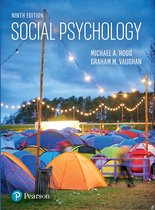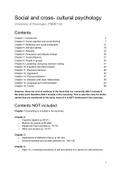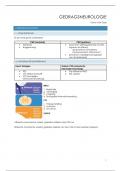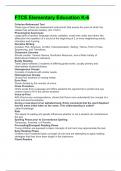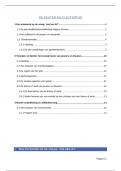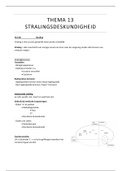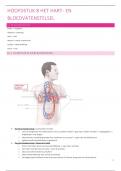University of Groningen, PSBE1-02
Contents
Chapter 1: Introduction 2
Chapter 2: Social cognition and social thinking 7
Chapter 3: Attribution and social explanation 13
Chapter 4: Self and identity 18
Chapter 5: Attitudes 22
Chapter 6: Persuasion and attitude change 28
Chapter 7: Social Influence 31
Chapter 8: People in groups 35
Chapter 9: Leadership and group decision-making 41
Chapter 10: Prejudice and discrimination 45
Chapter 11: Intergroup behavior 48
Chapter 12: Aggression 54
Chapter 13: Prosocial behavior 57
Chapter 14: Attraction and close relationships 59
Chapter 15: Language and communication 63
Chapter 16: Culture 66
However, there are a lot of sections in the book that our university didn’t include in
the exam and I therefore didn’t include in the summary. This is also the case for all the
names that are mentioned in the book, most of it is NOT mentioned in the summary.
Contents NOT included
Chapter 1: Everything is included in the summary
Chapter 2:
● Cognitive algebra (p.49-51)
● Memory for people (p.65-p69)
● Departures from normality (p. 70-72)
● Affect and emotion (p. 74-77)
Chapter 3:
● Applications of attribution theory (p. 92--94)
● Social knowledge and societal attribution (p. 105-110)
Chapter 4:
● Page 131, Contextual sensitivity of self and identity & In search for self-coherence
1
, ● Page 132, Processes of social identity salience up to page 135, until the end of the
part on Consequences of social identity salience
● Page 142 Individual differences up to page 146, until the end of the part on
Self-esteems sociometer
Chapter 5:
● Cognition and evaluation (starting p. 159, last paragraph)
● Do we perform cognitive algebra? (ending on top of page 162);
Chapter 6:
● Does fear work? (starting on page 205) through The sleeper effect
Chapter 7:
● The ethical legacy of Milgram's experiments (p. 253)
● Behavioral style and the genetic model (p. 266-268)
● Convergent-divergent theory (p. 271-272)
● Vested interest and the leniency contract (p. 273-274)
● Two processes or one? (p. 275)
Chapter 8: Everything included in the summary
Chapter 9:
● All subsequent sections from p. 329-343
○ Personality traits and individual differences
○ Situational perspectives
○ What leaders do
○ Contingency theories
○ Transactional leadership
○ Transformational leadership
○ Charisma and charismatic leadership
● Expectation states and status characteristics (p. 344)
● Group memory (p. 356-359)
● Jury verdicts (p. 365-367)
Chapter 10: Stigma and other effects of prejudice (see p. 395 to 403)
Chapter 11:
● Cooperation, competition, and social dilemmas (see p. 431-436)
● social categorization, prototypes, and depersonalization (see p 440)
● psychological salience (see p. 441)
● uncertainty reduction ( see p. 442)
● Collective behavior and the crowd (see p. 453 to p. 462)
Chapter 12:
● Page 493 Personality to page 494 (end of the part on Gender and socialization);
● Page 497 Alcohol to page 503 (end of the part on Sports events);
● Page 504 Societal influences to page 507 (end of the part on subculture of violence);
● Page 511 (Rape myths) to page 522 (end of the part on Reducing aggression).
2
,Chapter 13:
● The person in the equation until end of part on Health support networks (545-556)
● End of the part on Norms for helping until the end of the part on Volunteers and
martyrs (558-560)
Chapter 14:
● Social matching until the end of the part on self-disclosure and trust (p.573-577)
● Marriage until the end of the part of Consequences of failure (595-603)
Chapter 15:
● Language and vitality (p. 617-618)
● Bilingualism and second-language acquisition (p. 620-622)
● Variations in non-verbal behavior (p. 625-626)
● p. 630 from the sentence introducing the nature-nurture debate until p. 632. Start
reading again with the following section: Gaze and eye contact
● Conversion and discourse (p. 643-646)
Chapter 16:
● Origins in cultural anthropology (p. 657-658).
● Collectivism and prosocial behavior & Relationships (p. 671-674)
● Culture through the lens of norms and identity (p. 674-675)
● Testing social psychology cross-culturally (p. 681-684).
3
,Chapter 1: Introduction
Social psychology = the scientific investigation of how the thoughts, feelings and behaviors
of individuals are influenced by the actual, imagined or implied presence of others.
→ interested in explaining human behavior and NOT animals; behavior is
observable and measurable, refers not only to obvious motor activities but also more
to subtle actions such as a raised eyebrow, how we dress & what we say and write.
→ also interested in feelings, thoughts, beliefs, attitudes, intentions and goals;
are not directly observable.
Social psychologists map psychological aspects of behavior onto fundamental cognitive
processes and structures in the human mind, and sometimes to structures and
neuro-chemical processes in the brain.
Implied presence = It means the indirect presence of others that is implied; shaped by
societal roles and cultural norms.
Conformity = group expectations provide norms with powerful effects on an individual’s
behavior.
What makes social psychology distinct from for example sociology or political science is a
combination of what it studies, how it studies it and what level of explanation is sought.
→ science involves the formulation of hypotheses.
Adversarial collaboration = when researchers who champion different theories and work in
different labs with different research traditions collaborate closely in full openness to test
predictions from a specific theory.
Two types of methods for social psychology testing:
1. experimental
a. laboratory experiment
b. field experiment
2. non-experimental
a. archival research
b. case studies
c. qualitative research & discourse analysis
d. survey
e. field studies
Experimentation involves intervention in the form of manipulation of one or more
independent variables, and then measurement of the effect of the manipulation on one or
more dependent variables.
Confounding = where two or more independent variables covary in such a way that it is
impossible to know which has caused the effect.
→ is recorded in a lab to control as many potentially confounding variables as possible.
4
, fMRI = (functional magnetic resonance imaging) to measure where electrochemical activity
in the brain is occurring by oxygen levels.
Subject effects = effects that are not spontaneous, owing to demand characteristics and/or
participants wishing to please the experimenter.
Experimenter effects = effects produced or influenced by clues to the hypotheses under
examination, inadvertently communicated by the experimenter.
Archival research = non-experimental method involving the assembly of data, or reports of
data, collected by others. Useful for investigating large-scale, widely occurring phenomena
that may be remote in time.
Case study = in-depth analysis of a single case (or individual).
Discourse = entire communicative event or episode located in a situational and
socio-historical context.
Discourse analysis = a set of methods used to analyze text, in particular, naturally
occurring language, in order to understand its meaning and significance.
Field study is the same as a field experiment, but without any interventions are
manipulations.
Survey research is used to predict people’s actions, such as voting. They have problems
that need to be addressed (sampling error, investigator bias, and people’s mistrust of being
questioned).
Statistics is used to investigate the magnitude and/or significance of effects
- t-test is a procedure to test the statistical significance of an effect in which the mean
for one condition is greater than the mean for another
- an effect is statistically significant if statistics reveal that it, or a larger effect, is
unlikely to occur by chance more often than 1 in 20 times.
Informed consent = permission granted in full knowledge of the possible consequences.
Debriefing = the researchers would explain why they used deception and explain the
purpose of it.
Social identity = a similar dress style and hanging out together are cues at least to a
temporary shared group membership.
Metatheory = a set of interrelated concepts and principles concerning which theories or
types of theory are appropriate.
Theories in social psychology
● Behaviorism
Radical behaviorist = one who explains observable behavior in terms of
reinforcement schedules without recourse to any intervening unobservable (e.g.
cognitive) constructs.
5

